MR Safety: PNS & RF Heating
MR Safety: PNS & RF Heating
Oral
Oral
MR Safety
Wednesday, 15 May 2019
| Room 511BCEF | 08:15 - 10:15 | Moderators: Cem Deniz, Simon Graham |
08:15 |
0726. 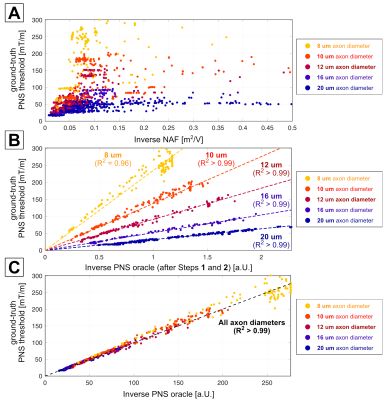 |
The PNS oracle: a modified neural activation function metric for rapid assessment of Peripheral Nerve Stimulation (PNS)
Mathias Davids, Bastien Guérin, Valerie Klein, Lothar Schad, Lawrence Wald
As gradient engineering advances, Peripheral Nerve Stimulation (PNS) increasingly limits MRI gradient coil use. The ability to predict a winding pattern’s PNS threshold could be useful during design iteration, but recently introduced methods for simulating the threshold in full body models including nerve atlases and neurodynamic simulations are computationally slow. Here we present a simple PNS oracle which is linear (with respect to the E-field) that allows prediction of the gradient-induced stimulation threshold without relying on full neurodynamic modeling. We validated the fast oracle against the full neurodynamic model in multiple gradient coils and two body models.
|
08:27 |
0727. 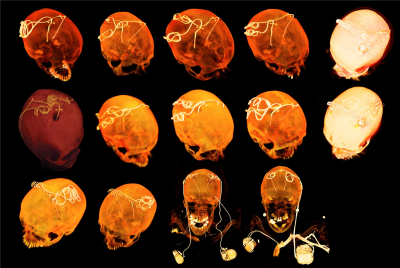 |
Reconfigurable coil technology significantly reduces the SAR at the tips of bilateral deep brain simulation leads during MRI at 3T: A realistic case study of isolated leads and fully-implanted systems
Ehsan Kazemivalipour, Ergin Atalar, Alireza Vali, Boris Keil, Julie Pilitsis , Laleh Golestanirad
We report simulation results of specific absorption rate (SAR) at tips of bilateral deep brain stimulation (DBS) implants using a recently introduced reconfigurable MRI coil technology which uses a mechanically rotating linearly polarized birdcage transmitter. Using patient-derived realistic models of DBS leads both in isolation (i.e., leads that are not yet connected to the pulse generator) and fully-implanted DBS systems with different implanted pulse generator (IPG) configurations (i.e., a single dual-channel IPG feeding both leads, or two single-channel IPGs feeding left and right leads separately), we show that the rotating coil technology significantly reduces the SAR simultaneously at left and right leads during MRI at 3T.
|
08:39 |
0728. 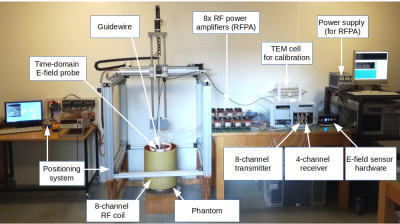 |
Parallel transmission medical implant safety testbed: First application using time-domain E-field probes to measure and mitigate RF induced currents
Lukas Winter, Frank Seifert, Werner Hoffmann, Harald Pfeiffer, Sandy Szermer, Frank Wojcik, Reiner Seemann, Bernd Ittermann
A parallel transmission (pTx) implant safety testbed has been developed, that allows to investigate manifold MR safety related scenarios. The testbed can be used to investigate sensor-feedback methods, perform validation measurements of MR based current detection methods and investigate the MR safety of a variety of implants for various clinical MR settings from 1.5T to 7T. Preliminary results were acquired using a time-domain E-field probe to measure RF induced currents on a guidewire substitute at f=297 MHz and to mitigate these currents with pTx pulses.
|
08:51 |
0729. 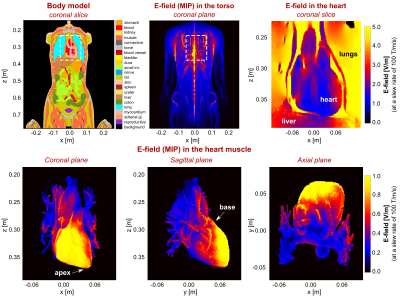 |
Simulation of MRI gradient-induced cardiac stimulation: Are the current safety regulations too conservative?
Valerie Klein, Mathias Davids, Lothar Schad, Lawrence Wald, Bastien Guérin
Current MR safety standards significantly limit the use of some MRI gradient systems to prevent cardiac stimulation, even though there is suspicion that these limits are too restrictive. This work combines a recently developed simulation framework for Peripheral Nerve Stimulation (PNS) with electrical models of excitable cardiac tissue (ventricular muscle and Purkinje fibers) to investigate the relationship between PNS and cardiac stimulation thresholds. Considering the lack of experimental data on gradient-induced cardiac stimulation in humans, the presented simulation approach could provide valuable new insights on the mechanisms behind cardiac magnetostimulation and might eventually help to determine appropriate safety limits.
|
| 09:03 |
0730.  |
Computational modeling of RF-induced heating due to a titanium-alloy rod: An Interlaboratory Comparison for the ASTM F2182 task group
Kyle Murdock, David Gross, Alan Leewood, Peter Serano, Marc Horner, John Nyenhuis, Payman Afshari, Daniel Moreno, Joshua White, Rada Alnnasouri, Pauline Ferry, Yannick Ponvianne, Mikhail Kozlov, Claus Gerber, Cesar Bibiano, Sunder Rajan, Leonardo Angelone
Computational modeling of RF-induced heating due to a titanium-alloy rod was conducted by nine independent institutions with a primary goal to compare the impact of common, independent modeling choices on temperature rise results. Results showed that when the rod is located 2 cm from the enclosure, the temperature rise can be used to estimate the local background electric-field exposure. Temperature rise depends not only on the background exposure but also on the location of the rod within the phantom.
|
09:15 |
0731. 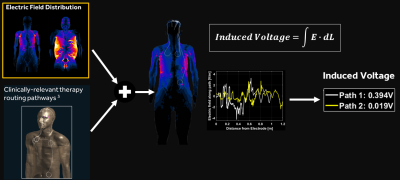 |
Predicting In Vivo MRI Gradient-Induced Voltage Levels on Deep Brain Stimulation Systems Using Artificial Neural Networks
M. Arcan Erturk, Mark Conroy, Jacob Chatterton, Riki Banerjee
MRI gradient-fields may cause unintended interactions due to induced voltage potential along elongated conductive components of active implanted medical devices, therefore devices must be tested at clinically-relevant exposure levels. In vivo gradient-induced voltage levels on implanted deep brain stimulation (DBS) systems are simulated in adult human anatomical models. Then, artificial neural network (ANN) models are trained to predict gradient-induced voltages on DBS systems. Predictive ANN models demonstrated good accuracy (RMSE<0.180V). Leave-one-model-out cross-validation results demonstrate that ANN models can perform accurate predictions in general population if a variety of anatomical models representative of the population are included in the training dataset.
|
09:27 |
0732. 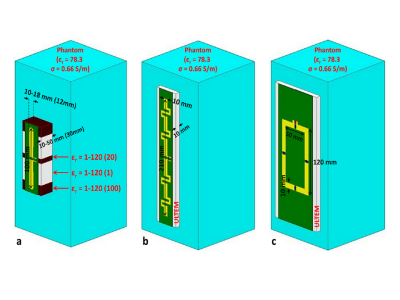 |
A New Coil Element for Highly-Dense Transmit Arrays : An Introduction to Non-Uniform Dielectric Substrate (NODES) Antenna
Alireza Sadeghi-Tarakameh, Steve Jungst, Xiaoping Wu, Mike Lanagan, Gregor Adriany, Gregory Metzger, Pierre-Francois Van de Moortele, Kamil Ugurbil, Ergin Atalar, Yigitcan Eryaman
Ultra-high field (UHF)-magnetic resonance imaging (MRI) provides numerous benefits such as a significant increase in signal-to-noise ratio (SNR) however, the local specific absorption rate (SAR) becomes a limiting factor in many applications. Utilizing a proper TxArray coil with an adequate number of elements and improved SAR performance may provide a good solution for this issue. In this work, we propose to use a short antenna with a Non-uniform Dielectric Substrate (NODES) which provides an opportunity to design a highly-dense TxArray with improved SAR performance.
|
| 09:39 |
0733 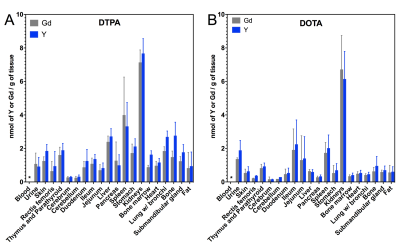 |
Gadolinium retention in tissues: yttrium as a gadolinium surrogate to investigate the in vivo biodistribution of the retained gadolinium Video Permission Withheld
Mariane LE FUR, Alana Ross, Peter Caravan
Gadolinium has been found in the brain, skin and bone of patients with normal renal function months to years after the last administration of a gadolinium-based contrast agent (GBCA). Yttrium (Y3+) has similar size and chemical properties to Gd3+. We investigated whether yttrium can be used as a gadolinium surrogate by measuring the biodistribution of Gd-DTPA/Y-DTPA and Gd-DOTA/Y-DOTA (0.6 mmol/kg) in mice. Residual Gd and Y levels 7 days after injection showed a Y:Gd ratio close to 1 in all organs demonstrating that Y can act as a surrogate for Gd.
|
09:51 |
0734. 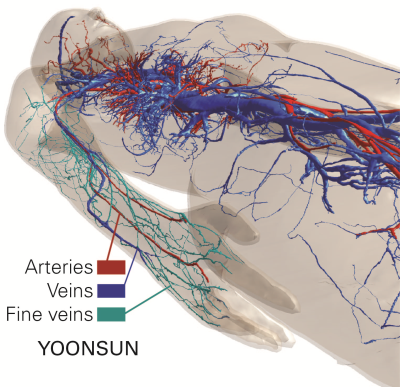 |
MRI RF Heating: The Effect of Vasculature Detailedness on Numerical Temperature Increase Estimations
Manuel Murbach, Bryn Lloyd, Silvia Farcito, Esra Neufeld, Niels Kuster
The numerical assessment of the radiofrequency (RF)-induced local temperature increase inside a patient undergoing magnetic resonance imaging (MRI) diagnostics is state-of-the-art in MRI safety studies. In light of the continuous improvement in the resolution of anatomical models, we investigated the impact of the level of detail in the vasculature models on estimates of temperature increase. Results show that the difference of the peak temperature increase for the investigated high-exposure scenario is in the order of 20%. Future investigations should broaden the studied exposure scenarios and consider vascular convection.
|
| 10:03 |
0735. 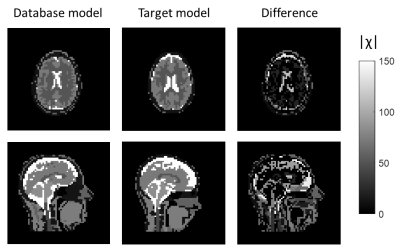 |
Accelerated SAR Computations by Exploiting Sparsity in the Anatomical Domain
Wyger Brink, Jeroen van Gemert, Rob Remis, Andrew Webb
Accelerated SAR computations can improve awareness on actual RF exposure levels, which are known to depend heavily on subject anatomy. In this work, we accelerate SAR computations by reformulating the underlying electromagnetic field equations in terms of anatomical differences rather than the entire anatomy itself. This yields a “sparse” representation of the target anatomy, reducing problem complexity without compromising accuracy.
|
 Back to Program-at-a-Glance |
Back to Program-at-a-Glance |  Back to Top
Back to Top